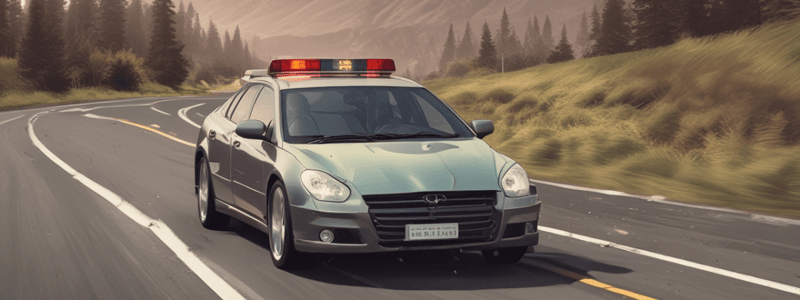Podcast
Questions and Answers
What is a major concern when driving through a flooded road?
What is a major concern when driving through a flooded road?
- Getting lost in the water
- Vehicle overheating
- Electrocution from fallen power lines (correct)
- Collision with other vehicles
Why should you reduce your speed when driving in high winds?
Why should you reduce your speed when driving in high winds?
- To reduce noise pollution
- To avoid hydroplaning
- To improve fuel efficiency
- To have more time to react to gusts (correct)
What should you do after driving through a flooded road?
What should you do after driving through a flooded road?
- Check your oil level
- Test your brakes (correct)
- Check your tire pressure
- Refuel immediately
Why should you maintain a firm hand position on the steering wheel while driving in high winds?
Why should you maintain a firm hand position on the steering wheel while driving in high winds?
What should you avoid using while driving in high winds?
What should you avoid using while driving in high winds?
When are fines doubled in highway construction or maintenance zones?
When are fines doubled in highway construction or maintenance zones?
What is required of drivers when encountering emergency or road work vehicles?
What is required of drivers when encountering emergency or road work vehicles?
What does a diamond-shaped sign on a truck indicate?
What does a diamond-shaped sign on a truck indicate?
In what conditions must you drive slower?
In what conditions must you drive slower?
When towing a vehicle or trailer, which lane should you drive in?
When towing a vehicle or trailer, which lane should you drive in?
What is recommended to avoid when driving in heavy fog or smoke?
What is recommended to avoid when driving in heavy fog or smoke?
What should you do if the fog becomes too thick to drive safely?
What should you do if the fog becomes too thick to drive safely?
What is the purpose of law enforcement traffic breaks during heavy fog or unusual traffic conditions?
What is the purpose of law enforcement traffic breaks during heavy fog or unusual traffic conditions?
What should you do when approaching a law enforcement traffic break?
What should you do when approaching a law enforcement traffic break?
What should you avoid using when driving in heavy fog or smoke?
What should you avoid using when driving in heavy fog or smoke?
What should you do when experiencing sun glare while driving?
What should you do when experiencing sun glare while driving?
Why should you avoid driving during sunrise and sunset?
Why should you avoid driving during sunrise and sunset?
What should you do when you encounter a vehicle with one headlight driving towards you?
What should you do when you encounter a vehicle with one headlight driving towards you?
Why should you reduce your speed in highway construction zones at night?
Why should you reduce your speed in highway construction zones at night?
What can cause your vehicle to skid on the road?
What can cause your vehicle to skid on the road?
Flashcards are hidden until you start studying
Study Notes
Safe Driving Practices
- In heavy fog or smoke, consider postponing your trip until the fog clears, or drive slowly with low-beam headlights, and increase following distance.
- In heavy fog or smoke, make sure you can stop within the space you can see ahead, and avoid crossing lanes or passing traffic unless absolutely necessary.
Law Enforcement Traffic Breaks
- During a traffic break, an officer turns on their emergency lights and slowly weaves across lanes to slow or stop traffic.
- When encountering a traffic break, turn on your emergency flashers, slow down, keep a safe distance from the patrol vehicle, and do not drive past the patrol vehicle.
Flooded Roads
- Be cautious when driving on flooded roads, as excess water can sweep you off the road, conceal hazards, or cause vehicle malfunctions.
- If possible, find an alternative route, and if not, drive slowly and test your brakes after crossing the water.
High Winds
- Reduce speed when driving in high winds, especially with larger vehicles, to maintain control and react to gusts.
- Maintain a firm grip on the steering wheel, be alert, and avoid using cruise control.
Hazardous Loads
- Be aware of diamond-shaped signs on trucks, indicating hazardous loads, which must stop before crossing railroad tracks.
Heavy Traffic or Bad Weather
- Drive slower in heavy traffic or bad weather, but avoid blocking normal traffic flow by driving too slowly.
Towing
- When towing a vehicle or trailer, drive in the far-right lane or a lane marked for slower vehicles.
Night Driving
- Use low-beam headlights when driving at night, and reduce speed in highway construction zones.
- Be cautious of pedestrians, bicyclists, and motorcyclists, who are harder to see at night.
Sun Glare
- To manage sun glare, keep your windshield clean, wear polarized sunglasses, and maintain space between vehicles.
Skids
- A skid occurs when one or more tires lose traction, making it difficult to control the vehicle.
- Slippery surface skids can occur on icy or snowy roads, especially when driving too fast or downhill.
Studying That Suits You
Use AI to generate personalized quizzes and flashcards to suit your learning preferences.




